| Roger Reini's Bahá'í Pilgrimage Journal | ||
| First Attempt Prelude to Departure Departure for the Holy Land Day 1 Day 2 Day 3 Day 4 Day 5 Day 6 Day 7 Day 8 Day 9 Return Home Pilgrimage Home Page |
Day 6 December 29, 2007 I woke up a bit earlier than I have been lately. The restaurant did not open until 7, so I went down around 7:30 and had my usual. I walked down the public stairs to the PRC, for the timing was not right for the Terraces. I stopped by an ATM to see if I could get some cash, but it was out of order, or it may have been shut down for the Sabbath. Not all of that trip was downhill, so I was a bit warm when I got to the PRC. I met up with the Kellys and with the Saadi family, and at 10 we boarded our sherut for ‘Akká. The driver took us through parts of Haifa I hadn’t yet seen; driving a vehicle smaller than a bus, he was not limited to the bus routes. Eventually we got on a road I recognized, and we reached ‘Akká with little difficulty. There was a bit of difficulty in negotiating where we wanted to be picked up; Mr. Saadi ended up talking to the sherut dispatcher, whose command of English was better than the driver’s. But we got it figured out. 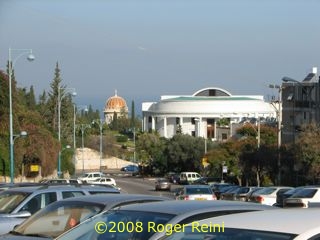 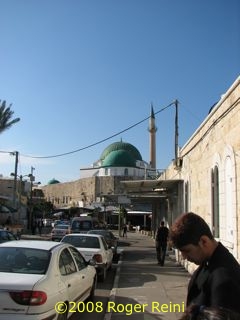 We went inside a craft store near the police station by the citadel; I didn’t get anything. I did find a working ATM nearby and got 500 shekels. Then we set off on our journey around town. We had maps showing us the important sites related to the Faith, and we made sure to stay on the route marked in red. Our pilgrim badges were tucked away; it was deemed unwise to wear them here. After we confirmed on the map where we were, we walked through the White Bazaar area. The sights and sounds of all sorts of food surrounded us. Several vendors asked if we wanted anything; we said it was too soon -- at least I did. 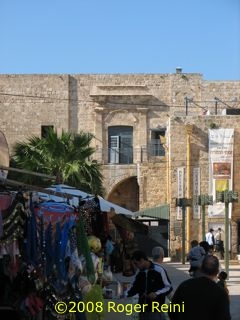 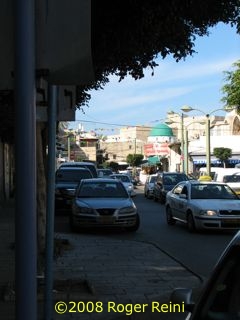 We went through the Khán-i-Shavirdi, where Bahá’u’lláh was briefly held and interrogated after an incident where several enemies of the Faith were killed (I’m referring to the Azalís). He had nothing to do with it; indeed, He had expressly forbade it, but the perpetrators did it anyway. He was soon released. Next came a walk along the eastern seawall, past the Sinan Basha mosque, and then into the Khán-i-Avamid (known locally as the Khan El-Omdan). Here, many of the early believers lived. On the upper floor was a room that served as the first Pilgrim House. Here we were, following in those first pilgrims’ footsteps. 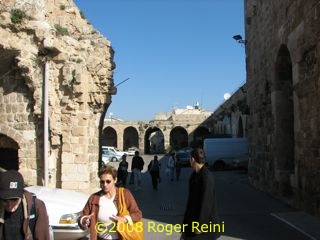 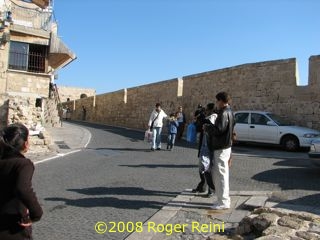 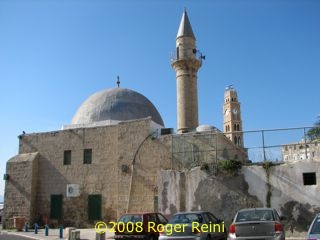 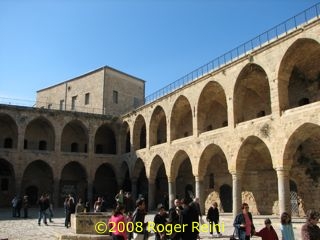 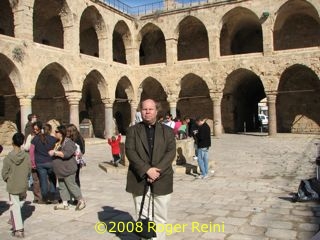 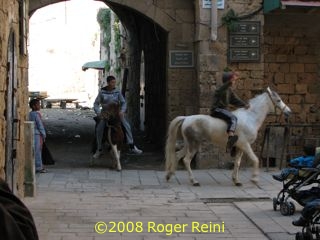 We walked down to the Pisan Harbour and saw what was left of the Sea Gate, through which Bahá’u’lláh and His family first entered the city. The water was clear and shallow; I could easily see the bottom. I also saw a few jellyfish swimming around. Mount Carmel was visible in the distance; I could see the hotels on top, but it was too hazy to make out the Shrine of the Báb or the Terraces (although in a photo I took, I could just make out some of the buildings of the Arc). At one point, I saw a white horse and a pony being ridden through the streets. 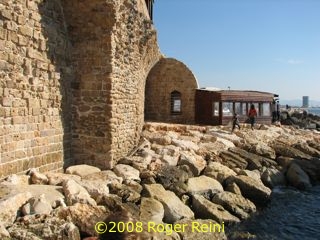 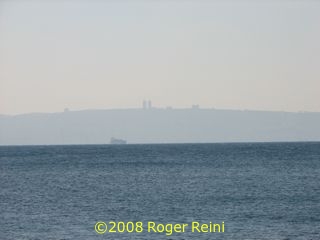 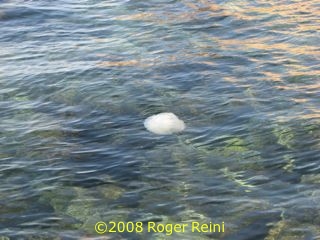 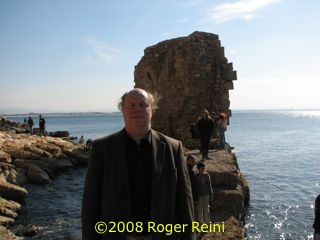 Due to time constraints, we did not continue our walk around the city. Instead, we retraced our steps and returned to the white bazaar area, where we split up for lunch. I went with the Kellys, and we ate at a sidewalk café, dividing up some hummus and falafel. Best falafel I ever had! It must be so much better when freshly cooked. They picked up my share of the bill; I could repay them by “buying” them tea at the Bahjí visitor center (the cost: prayer). We stopped at a little shop along the way. Nicole and I looked at the ouds, guitar-like instruments (9-string guitar). I saw one there that looked somewhat like a 12-string banjo (not tuned like a 12-string, though). I didn’t buy anything there. Then it was back to our prearranged meeting place to wait for the sherut. Traffic was much heavier now (1 PM) than when we first arrived. 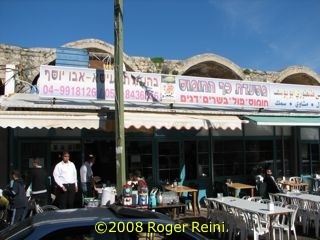 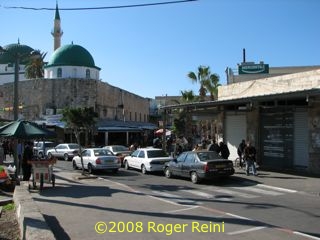 Our next stop was Bahjí. We arranged to have our driver return for us at 3:30 PM (in retrospect, this may not have been the best decision). Once inside the visitor center, I attempted to repair my badge holder, the clip for which had broken in my pocket. Kian Tavackoli attempted to assist me. I had all the parts, but it appeared something had broken off the retaining pin. It was irreparable. I could use the safety pin to attach it to my shirt, though, so that’s what I did. I went for some tea. Dr. Khan was present, though I did not speak to him. Then I walked to the Haram-i-Aqdas and entered the Shrine. I said my obligatory prayer while facing the Sacred Threshold (said it silently, of course); one doesn’t get many opportunities to do that! I then bowed before the Threshold after first placing my prayer book there, and I moved to the room immediately to the right for prayer and meditation and contemplation. I said my prayers for the tea, and then I said the additional prayers requested by the Detroit-area friends that I received in the last few days. I don’t recall how long I was there, 45 minutes to an hour, probably. Once again, I placed my prayer book at the Threshold and bowed down at it (the Threshold), and then I took my leave. Next, I went to the Bahjí Pilgrim House and saw the room of the Master (I offered a prayer of His for humanity in His room). I walked around parts of the gardens I had not previously visited, and then I briefly visited the Mansion (“briefly” because the time for our sherut was approaching). I visited the room of the Blessed Beauty again. Today, I did not kneel or bow; instead, I stood at a cross between Attention and At Ease -- “easy attention” or “attentive ease”. I offered no specific prayers; I just stood there with an attitude of respect and reverence, soaking in the spiritual atmosphere. 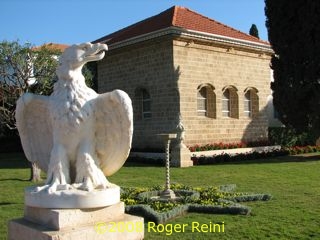 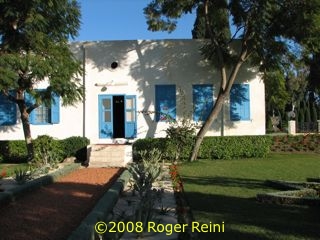 It was time to leave, and I hurried back to the front gate. Our sherut was there, but half of the group was staying. We picked up one more and started back with 6 people, so we might have had to pay more on this trip. The driver picked up and let off other passengers en route, allowing us to pay 15 shekels, little more than the outbound trip. Back at the PRC, I saw the furry gray cat that had hung around the building a lot. The tip of its left ear was missing, as though it had been cut or bitten off. Is there a dog named Mike Tyson running around? I walked over to the Shrine of the Báb, set my camera up on a tripod, and took some 1-second exposures of the city and the Shrine, trying to capture the dusk light. I even took a 2-second exposure of the Shrine, though it was little different from the 1-second exposure. I noted the orange trees flanking the steps; these had been grown from seeds from the orange tree at the House of the Báb in Shiraz, Iran. 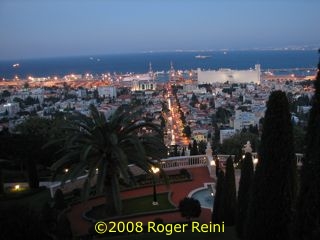 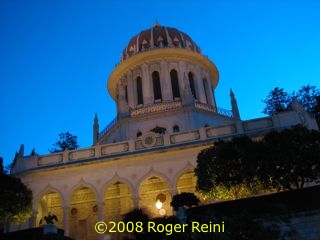 It was chilly with the wind, so I went inside the Shrines. The doors were heavy, but I knew by now how to open and close them without making noise (I wasn’t so fortunate the first time). I was inside the Shrine of the Báb for 30 minutes and the Shrine of ‘Abdu’l-Bahá for 15. While inside, I could hear the wind kicking up. The prayers that I offered, I’ll keep a secret. When I left the Shrine, I went to the Pilgrim House and perused the library. I read from (scanned, to be more accurate) Door of Hope by David Ruhe, a book on the holy sites in the ‘Akká and Haifa areas. Back at the PRC, my supper consisted of a small container of hummus and an Atkins caramel bar. It might not sound like much, but it was good. It was time to go back to the hotel, but I had a hard time doing so. Buses were running on a reduced schedule for the Sabbath, which had technically ended at sunset. Any buses that came by were few and far between, and none seemed to be the one I wanted. I got very concerned. If it were light, I might have braved the stairs up to the top of the mountain, but I was reluctant to do so at night. With growing trepidation, I started reciting the Remover of Difficulties prayer. Not long afterward, a sherut driver going down hill saw me and stopped. The buses have stopped running, he said. I asked him the rate to the Panorama and I thought he said 40 shekels. I gave him a 20 thinking it was a 100, then gave him a 100. And we set off. At the top, though, he said it was 140 shekels. I still owed 20 shekels [note that I had just hired a 10-passenger sherut just for myself]. The smallest bill I had was a 100, so that’s what he got. No change. So he got a very nice tip from me. I was chagrined at such an expensive ride. But my prayer had been answered. Next: Day 7 Back: Day 5 Up: Pilgrimage Home Page DISCLAIMER: this is not an official page of any Bahá'í Institution. All comments are my own and derive from my personal understanding of the Bahá'í Teachings. For official information about the Bahá'í Faith, you may wish to visit www.bahai.org or www.bahai.us. Text ©2008 Roger W. Reini. Photos ©2008 Roger W. Reini except where noted. Photos marked "© Bahá'í International Community" are reproduced with permission of the Bahá'í International Community (http://media.bahai.org/). Written
by Roger Reini |
|